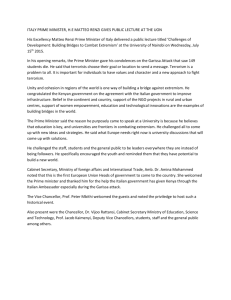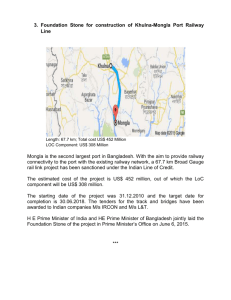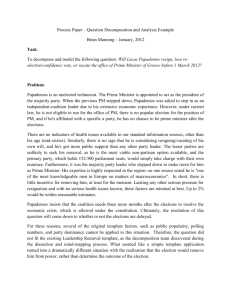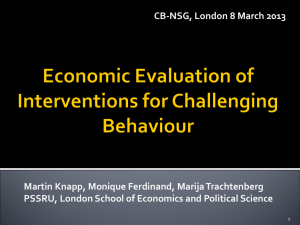Bibliography - Marcus J. Henglein
advertisement
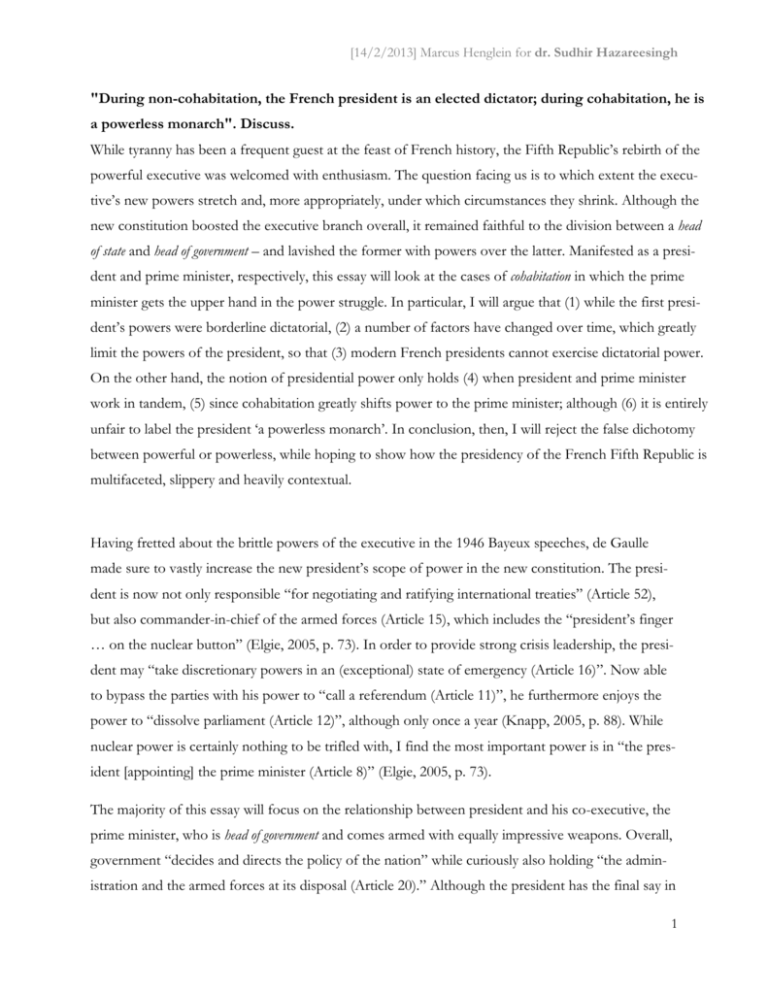
[14/2/2013] Marcus Henglein for dr. Sudhir Hazareesingh "During non-cohabitation, the French president is an elected dictator; during cohabitation, he is a powerless monarch". Discuss. While tyranny has been a frequent guest at the feast of French history, the Fifth Republic’s rebirth of the powerful executive was welcomed with enthusiasm. The question facing us is to which extent the executive’s new powers stretch and, more appropriately, under which circumstances they shrink. Although the new constitution boosted the executive branch overall, it remained faithful to the division between a head of state and head of government – and lavished the former with powers over the latter. Manifested as a president and prime minister, respectively, this essay will look at the cases of cohabitation in which the prime minister gets the upper hand in the power struggle. In particular, I will argue that (1) while the first president’s powers were borderline dictatorial, (2) a number of factors have changed over time, which greatly limit the powers of the president, so that (3) modern French presidents cannot exercise dictatorial power. On the other hand, the notion of presidential power only holds (4) when president and prime minister work in tandem, (5) since cohabitation greatly shifts power to the prime minister; although (6) it is entirely unfair to label the president ‘a powerless monarch’. In conclusion, then, I will reject the false dichotomy between powerful or powerless, while hoping to show how the presidency of the French Fifth Republic is multifaceted, slippery and heavily contextual. Having fretted about the brittle powers of the executive in the 1946 Bayeux speeches, de Gaulle made sure to vastly increase the new president’s scope of power in the new constitution. The president is now not only responsible “for negotiating and ratifying international treaties” (Article 52), but also commander-in-chief of the armed forces (Article 15), which includes the “president’s finger … on the nuclear button” (Elgie, 2005, p. 73). In order to provide strong crisis leadership, the president may “take discretionary powers in an (exceptional) state of emergency (Article 16)”. Now able to bypass the parties with his power to “call a referendum (Article 11)”, he furthermore enjoys the power to “dissolve parliament (Article 12)”, although only once a year (Knapp, 2005, p. 88). While nuclear power is certainly nothing to be trifled with, I find the most important power is in “the president [appointing] the prime minister (Article 8)” (Elgie, 2005, p. 73). The majority of this essay will focus on the relationship between president and his co-executive, the prime minister, who is head of government and comes armed with equally impressive weapons. Overall, government “decides and directs the policy of the nation” while curiously also holding “the administration and the armed forces at its disposal (Article 20).” Although the president has the final say in 1 [14/2/2013] Marcus Henglein for dr. Sudhir Hazareesingh appointing ministers, the prime minister “has the right to propose the names of government ministers to the president” (Elgie, 2005, p. 73). Though still responsible to its lower house, Article 48 ensures that “the government enjoyed … priority for its bills on the parliamentary agenda” (Knapp, 2005, p. 88), while handily holding the right to “compel parliament to vote on the government version of any bill (Article 44)” (Knapp, 2005, p. 88). Government’s power interestingly includes a potentially dangerous relic from the Fourth Republic, namely the “rights to declare any bill a question of confidence” (Article 49.3), a right often invoked in the Fourth Republic to scare the Assembly from overusing its power to dissolve governments. Why this hasn’t turned out to be the case is partly because of the weakened status of the lower house, more likely because of a new Electoral system designed to promote majorities and lessen fragmentation. Parodi notes that “it is this that allows the president to entertain realistic hopes of a favourable parliamentary majority when he uses the right of dissolution” (Knapp & Wright, 2001, p. 87). Yet in times of non-cohabitation, where a majority in the assembly supports the president, the notion of a ‘dual executive’ feels rather misleading. Presidential power is channelled through the prime minister, a loyal ally, who works in tandem with the president, although this relationship to a large extent strikes one as that of a puppet and a puppeteer. Take the case of President Jacques Chirac, who appointed Jean-Pierre Raffarin as prime minister after the 2002 election. “When he was appointed Raffarin made it clear that his task was to implement the president’s policies of his new government.” (Elgie, 2005, p. 75). While the president has limited power to directly control the prime minister, the president can be overwhelmingly persuasive. Firstly, the power to appoint a prime minister means he can cherry-pick his closest ally. Secondly, should the prime minister decide to oppose the president for whatever reason, “the prime minister may be dispensed with at any time” (Knapp & Wright, 2001, p. 111). In this sense, Raffarin’s manoeuvrability seems restricted to the path that he, incidentally, chose. Evidently, then, the president holds a vast amount of power. I find that later presidents in non-cohabitation have been bogged down by a number of restraints, while only the first president, de Gaulle, can reasonably be classified as an ‘elected dictator’. With a “75.5 per cent of the vote” (Gaffney, 2010, p. 35), de Gaulle was elected President in 1958 by an electoral college. Indeed, a purely structural analysis of this period would find it hard to fit in the overwhelming role of de Gaulle: he “commanded a unique range of resources … including the legitimacy procured by his wartime role as leader of Free France, the trust he commanded as the only man capable of handling the Algerian emergency, and the lasting discredit into which the Fourth Republic had fallen” 2 [14/2/2013] Marcus Henglein for dr. Sudhir Hazareesingh (Knapp & Wright, 2001, p. 92). De Gaulle felt the president of the French Union lacked legitimacy without the people’s explicit backing, thus “It was the 1962 constitutional reform establishing the direct election of the president that created the system we know today.” (Elgie, 2005, p. 74). Not only was “the reform was passed in a referendum” (Elgie, 2005, p. 74), de Gaulle won a clear victory in 1965 which further fuelled the extent of the president’s powers. Especially de Gaulle “enjoyed a much higher political profile, thanks first to the general authority entrusted him …, second because he was de Gaulle” (Knapp, 2005, p. 88). I will highlight three examples of quasi-dictatorial power. Firstly, de Gaulle empowered himself with the right to sack any prime minister he had appointed by requiring them to supply undated letters of resignation - even though this power was not mentioned in the constitution (Knapp, 2005, p. 93). As previously argued, I found this of fundamental importance in understanding the president’s role as a puppeteer. Secondly, while de Gaulle was determined to ensure “adequate crisis leadership”, he certainly pushed this notion to the limit. Using his emergency powers in the ‘general’s putsch’ in Algiers in April 1961, he “stretched them to the limit by keeping [them] in force for five months (the putsch had lasted less than a week) and by taking the opportunity to sack or transfer army officers” and a number of other liberties (Knapp, 2005, p.84). This certainly reeks of uninhibited, centralized power and not far from the notion of dictatorship. Thirdly, de Gaulle stormed forward with a bold austerity package and currency reform, which “belong less obviously in the president’s ‘reserved domain’” (Knapp & Wright, 2001, p. 107), a trend that pervaded his presidency; another notable example in 1968 with “the presidential refusal … to devalue [the] franc”, which “astounded not only the financial world but also the Prime Minister and government”. This, I find, supports my point that de Gaulle was a supreme executive in a supposedly semipresidential system. The Fifth Republic has since then strayed far from the path of quasi-dictatorship, chiefly due to the rising powers of the legislative and judicial branches (Knapp, 2005, pp. 89-90)., which work especially well in tandem, but also a number of other factors that I’ll briefly touch upon: unpopularity, European integration and decentralization. The increasing power of the judiciary branch has been most significant in terms of checks and balances on the executive. Knapp outlines the evolution of three distinct judicial bodies, “the Council of State, the Constitutional Council, and the ordinary criminal judiciary” (Knapp, 2005, p. 94), and while both the Council of State and criminal judiciary play important roles, I will focus primarily on the Constitutional Council, which “like the US Supreme Court … is the supreme jurisdiction for the verification of the constitutionality of legislation” (Knapp, 2005, p. 94). After a long period of non-activity, the Council’s role 3 [14/2/2013] Marcus Henglein for dr. Sudhir Hazareesingh was significantly enhanced in 1971, when the Council struck down a piece of legislation by reference “not to the main body of the constitutional text, but to its preamble, which in turn refers back to the 1789 Declaration of the Rights of Man and the Citizen.” (Knapp, 2005, p. 95). This vastly increased “the grounds on which the Council could question the constitutionality of a law” (Knapp, 2005, p. 95). This change doesn’t mean that whole laws are constantly struck down, although the Council “frequently refuses one or more articles, requires amendments, or stipulates a particular interpretation of a text as a condition of its being constitutionally acceptable.” (Knapp, 2005, p. 96), consequently then “all important bills are drafted in the expectation that they will be referred by the opposition.” (Knapp, 2005, p. 96). Indeed, we should also note the development in the legislative branch to fully appreciate this change: “the 1974 constitutional amendment [allowed] 60 deputies or 60 senators to refer a bill to the Constitutional Council” (Knapp & Wright, 2001, p. 91), which Knapp refers to as “the most important new power given to parliamentarians” (Knapp, 2005, p. 94). This meant that parliament was equipped with the non-trivial weapon of submitting bills to constitutional review, which certainly presents aspiring dictators with a sub-optimal framework, especially since “the executive … drafts most major legislation” (Knapp, 2005, p. 96). Although we should also appreciate the limitation on the limitation: “the Council’s decision can be overridden with relative ease by amending the Constitution, a procedure that requires the vote of an identical text by each chamber of parliament … at which three-fifths majority is required” (Knapp, 2005, p. 96). Unlike the cumbersome process of amending the US constitution, France enjoys the benefits of being a unitary state, so “no further confirmation is needed at sub-national level” (Knapp, 2005, p. 96). For instance, when the Constitutional Council opposed the Balladur government’s 1993 immigration legislation, they overturned the ruling by amendment (Knapp, 2005, p. 96) Knapp does, however, not share my appreciation for the wider role of the parliament. He argues that: “to view ‘parliament’ as a check on the executive is to imply an intrinsically adversarial relationship that does not really exist. For the two are linked by party” (Knapp, 2005, p. 91), yet surely there is an element of heterogeneity among the key issues held by party members. An unchecked executive could easily stray from the path of the party for arbitrary reasons, so even in non-cohabitation parliament serves as a restraint on the president’s scope of power. If parliament does not enjoy the current line of the president’s puppet, a vote of no confidence is all it takes to bring down government and force the president to rethink his game plan. Four other restraining factors have narrowed the president’s bubble of space. Firstly, the president has become increasingly unpopular: “Giscard in 1976 and 1980, Mitterand in 1984 and 1993, and 4 [14/2/2013] Marcus Henglein for dr. Sudhir Hazareesingh Chirac in late 1995 all reached depths of unpopularity unknown to de Gaulle or Pompidou” (Knapp & Wright, 2001, p. 128). While this naturally weakens his legitimacy, it also poses problems to the power to call referenda, “once the ultimate tool of heroic presidential leadership, [it] was transformed by the voters, successively, into de Gaulle’s nemesis in 1969, a damp squib in 1972 and 1988, a near-disaster for Mitterrand and for Europe in 1992, and a collective snub to the whole political class in 2000.” (Knapp & Wright, 2001, p. 128). This is very likely related to the fact that de Gaulle set the bar high and “none of his successors has seriously sought to imitate the General’s style” (Knapp, 2005, p. 67). Secondly, the increasing European integration means the president has lost sovereignty over a number of different industries and key issues, and “relatively little law or public policy can now be made in France without some reference to the EU’s norms and procedures.” (Smith, 2005, p. 121). Ultimately, this means that power has been spatially shifted upwards. Meanwhile, and thirdly, decentralisation of power has sapped the president by spatially shifting power down to local government (Kuhlmann, 2011, p. 313). Fourthly and finally, the booming media industry has taken over part of parliament’s scrutiny function (Knapp, 2005, p. 94). Although I still find the judicial constraint the most significant one, the horde of lesser restraints serve the purpose of underlining how the president in non-cohabitation is not an elected dictator. Although not all-powerful, the president enjoys great power when armed with a loyal prime minister and a majority in parliament. This final detail is, however, crucial: An opposing majority in the Assembly can dismiss the government by a vote of no confidence - the president can stubbornly insist on appointing his closest allies, only to watch the Assembly dismiss them over and over, making the Fourth Republic look increasingly stable in comparison. Presidents, therefore, tend pick the lesser evil in choosing a prime minister the opposition will accept. Appointments, then, are “largely formal” (Knapp & Wright, 2001, p. 115). This is the state of cohabitation in which the decision-making process within the executive exhibits a very different dynamic, “the case for Chirac in 1986, Balladur in 1993 and Jospin in 1997” (Knapp, 2005, p. 93). Indeed, the prime minister remains “unmovable as long as he retains the Assembly’s backing” and becomes the “nation’s chief policy-maker” (Knapp, 2005, p. 93) This is especially awkward because “President and prime minister require each other’s countersignatures for many important acts” – as I hinted at earlier, “the president remains both commander-inchief of the armed forces and a central foreign policy player”, yet the prime minister holds similar powers – and the president cannot then fully “exercise either role without reference to the prime 5 [14/2/2013] Marcus Henglein for dr. Sudhir Hazareesingh minister.” (Knapp & Wright, 2001, p. 113). In the case of foreign relations, however, a widespread consensus exists that this is strictly within the president’s reserved domain. Jospin, for instance, took it upon him to visit Israel in 2002, which was met with a significant level of hostility, indicating that while the prime minister may find him capable of trespassing on the president’s domain, he probably shouldn’t. Indeed, after 9/11 Chirac was the French representative to meet President Bush, not Jospin. Domestically, this is entirely different: “By virtue of Article 20 and 21 of the Constitution the prime minister is now able to formulate and implement policies of his/her own. By contrast, the president, now lacking the support of the prime minister and the parliamentary majority, becomes a figurehead.” (Elgie, 2005). Chirac was powerless as Jospin introduced a number of policies he wholeheartedly disagreed with. Whatever powers the president holds are “negative rather than positive, that is to say, the president can propose and implement very little” (Elgie, 2005, p. 76). He may, for instance, try to annoy the prime minister: “In February 2001 the President refused to allow the government’s bill on the future of Corsica to be placed on the agenda of the Council of Ministers” (Elgie, 2005, p. 74). He did, however, agree to do so only a week later. The president’s only hope of getting rid of the prime minister is by “dissolving the National Assembly in the hope of a changed majority, something that no president has yet attempted in time of cohabitation.” (Knapp & Wright, 2001, p. 115) – it could after all get a lot worse and as Chirac experienced in 1997, it is often worthwhile to be happy with what you’ve got. The main reason why I wouldn’t call the president a powerless monarch is that the prime minister, too, is restrained. Most importantly, the constant political pressure on prime minister severely handicaps him: “[He] must continuously convince the majority parties that he is their best electoral asset: a difficult task, because he faces not only the pressure of events, but also both a determined adversary in the Elyse and rival within his own camp.” (Knapp & Wright, 2001, p. 97). Equally important is the internal restraint in that “[he] has no interest as a presidential aspirant in assaulting the institutions of which he hopes, eventually, to become the guarantor” (Knapp & Wright, 2001, p. 113). Although one could conceive of politician who would be satisfied with leaving a prime ministerial legacy, it seems reasonable that most would strive for the prestige of the presidential office. Both Elgie and Knapp, however, point out the significance in that all “prime ministers [that] have run for president at the end of the period of cohabitation [have] been defeated” (Knapp, 2005, p. 94). Although three instances certainly don’t merit the label ‘significant’, one could provide a more qualitative ar6 [14/2/2013] Marcus Henglein for dr. Sudhir Hazareesingh gument for the proposition that cohabitation “power comes at a cost” (Elgie, 2005, p. 77) – after all, the blame is centred on the person in power. Cohabitation periods certainly favour the prime ministers in terms of power, but it’s a double-edged blade. The third point is the need for countersignatures on many procedures, so that while “the two heads of the executive remain political adversaries, even enemies, they also need each other.” (Knapp & Wright, 2001, p. 113). I have tried to show that modern presidents are neither all-powerful nor all-powerless at any points in time. I did, however, make the exception of de Gaulle, who, in virtue of his personality and the contextual factors surrounding his time, came closest to the notion of an elected dictator. The rising power of the Constitutional Council in the 1970s coupled with added parliamentary power to work in tandem with it was a crushing blow to any would-be dictators, while a number of factors such as European integration and decentralization shifted power away from the presidency. Indeed, “few would be ready to bet on a return of the republican monarch in all its Gaullist splendour.” (Knapp & Wright, 2001, p. 127). While no one in their right mind would claim that cohabitation does not come with much aggravation for the president, it hardly renders him entirely powerless. Still massively influential in foreign and military affairs, he also holds some negative powers to annoy or slow down the work of the prime minister. Moreover, the prime minister is himself restrained, mostly by the majority in parliament who holds his fate in their hands, but also internally from his own aspirations to one day become president. It may be more convenient to reduce the president to either allpowerful or all-powerless, although that would hardly reflect the truth. Bibliography Elgie, R. (2005). The Political Executive. In A. Cole, P. L. Gales, & J. Levy, Development in French Politics 3 (pp. 70-88). New York: Palgrave Macmillan. Gaffney, J. (2010). Political Leadership in France: From Charles de Gaulle to Nicolas Sarkozy. New York: Palgrave Macmillan. Knapp, A. (2005). Prometheus (Re-)Bound? The Fifth Republic Checks on Executive Power. In A. Cole, P. L. Gales, & J. Levy, Developments in French Politics 3 (pp. 88-104). New York: Palgrave Macmillan. Knapp, A., & Wright, V. (2001). Executive policy-making: The variable diarchy. In A. Knapp, & V. Wright, The Government and Politics of France (4th ed., pp. 101-132). Routledge: Routledge. Knapp, A., & Wright, V. (2001). The sources of executive power. In A. Knapp, & V. Wright, The Government and Politics of France (4th ed., pp. 81-100). New York: Routledge. 7 [14/2/2013] Marcus Henglein for dr. Sudhir Hazareesingh Kuhlmann, S. (2011, February 21). Decentralisation in France: The »Jacobin« State Stuck between Continuity and Transformation. Retrieved February 13, 2013, from Croatian Institute of Public Administration: http://en.iju.hr/ccpa/ccpa/downloads_files/2011-02%20Kuhlmann.pdf Smith, A. (2005). The Europeanization of the French State. In A. Cole, P. Le Gales, & J. Levy, Developments in French Politics 3 (pp. 105-121). New York: Palgrave Macmillan. 8

